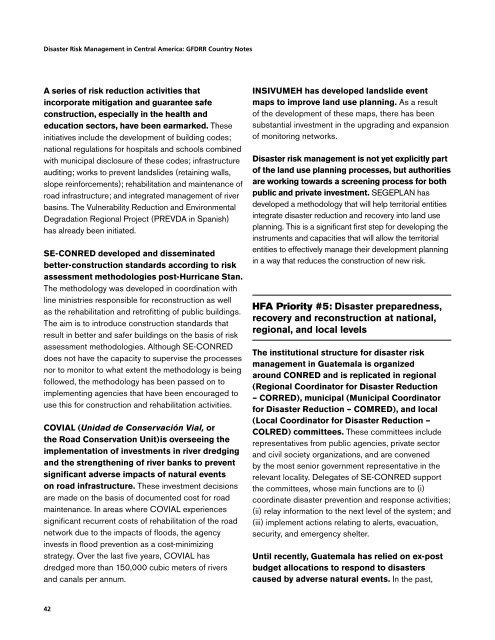Disaster Risk Management in Central America: GFDRR Country Notes
Disaster Risk Management in Central America: GFDRR Country Notes
Disaster Risk Management in Central America: GFDRR Country Notes
You also want an ePaper? Increase the reach of your titles
YUMPU automatically turns print PDFs into web optimized ePapers that Google loves.
<strong>Disaster</strong> <strong>Risk</strong> <strong>Management</strong> <strong>in</strong> <strong>Central</strong> <strong>America</strong>: <strong>GFDRR</strong> <strong>Country</strong> <strong>Notes</strong><br />
A series of risk reduction activities that<br />
<strong>in</strong>corporate mitigation and guarantee safe<br />
construction, especially <strong>in</strong> the health and<br />
education sectors, have been earmarked. These<br />
<strong>in</strong>itiatives <strong>in</strong>clude the development of build<strong>in</strong>g codes;<br />
national regulations for hospitals and schools comb<strong>in</strong>ed<br />
with municipal disclosure of these codes; <strong>in</strong>frastructure<br />
audit<strong>in</strong>g; works to prevent landslides (reta<strong>in</strong><strong>in</strong>g walls,<br />
slope re<strong>in</strong>forcements); rehabilitation and ma<strong>in</strong>tenance of<br />
road <strong>in</strong>frastructure; and <strong>in</strong>tegrated management of river<br />
bas<strong>in</strong>s. The Vulnerability Reduction and Environmental<br />
Degradation Regional Project (PREVDA <strong>in</strong> Spanish)<br />
has already been <strong>in</strong>itiated.<br />
SE-CONRED developed and dissem<strong>in</strong>ated<br />
better-construction standards accord<strong>in</strong>g to risk<br />
assessment methodologies post-Hurricane Stan.<br />
The methodology was developed <strong>in</strong> coord<strong>in</strong>ation with<br />
l<strong>in</strong>e m<strong>in</strong>istries responsible for reconstruction as well<br />
as the rehabilitation and retrofitt<strong>in</strong>g of public build<strong>in</strong>gs.<br />
The aim is to <strong>in</strong>troduce construction standards that<br />
result <strong>in</strong> better and safer build<strong>in</strong>gs on the basis of risk<br />
assessment methodologies. Although SE-CONRED<br />
does not have the capacity to supervise the processes<br />
nor to monitor to what extent the methodology is be<strong>in</strong>g<br />
followed, the methodology has been passed on to<br />
implement<strong>in</strong>g agencies that have been encouraged to<br />
use this for construction and rehabilitation activities.<br />
COVIAL (Unidad de Conservación Vial, or<br />
the Road Conservation Unit)is oversee<strong>in</strong>g the<br />
implementation of <strong>in</strong>vestments <strong>in</strong> river dredg<strong>in</strong>g<br />
and the strengthen<strong>in</strong>g of river banks to prevent<br />
significant adverse impacts of natural events<br />
on road <strong>in</strong>frastructure. These <strong>in</strong>vestment decisions<br />
are made on the basis of documented cost for road<br />
ma<strong>in</strong>tenance. In areas where COVIAL experiences<br />
significant recurrent costs of rehabilitation of the road<br />
network due to the impacts of floods, the agency<br />
<strong>in</strong>vests <strong>in</strong> flood prevention as a cost-m<strong>in</strong>imiz<strong>in</strong>g<br />
strategy. Over the last five years, COVIAL has<br />
dredged more than 150,000 cubic meters of rivers<br />
and canals per annum.<br />
INSIVUMEH has developed landslide event<br />
maps to improve land use plann<strong>in</strong>g. As a result<br />
of the development of these maps, there has been<br />
substantial <strong>in</strong>vestment <strong>in</strong> the upgrad<strong>in</strong>g and expansion<br />
of monitor<strong>in</strong>g networks.<br />
<strong>Disaster</strong> risk management is not yet explicitly part<br />
of the land use plann<strong>in</strong>g processes, but authorities<br />
are work<strong>in</strong>g towards a screen<strong>in</strong>g process for both<br />
public and private <strong>in</strong>vestment. SEGEPLAN has<br />
developed a methodology that will help territorial entities<br />
<strong>in</strong>tegrate disaster reduction and recovery <strong>in</strong>to land use<br />
plann<strong>in</strong>g. This is a significant first step for develop<strong>in</strong>g the<br />
<strong>in</strong>struments and capacities that will allow the territorial<br />
entities to effectively manage their development plann<strong>in</strong>g<br />
<strong>in</strong> a way that reduces the construction of new risk.<br />
HFA Priority #5: <strong>Disaster</strong> preparedness,<br />
recovery and reconstruction at national,<br />
regional, and local levels<br />
The <strong>in</strong>stitutional structure for disaster risk<br />
management <strong>in</strong> Guatemala is organized<br />
around CONRED and is replicated <strong>in</strong> regional<br />
(Regional Coord<strong>in</strong>ator for <strong>Disaster</strong> Reduction<br />
– CORRED), municipal (Municipal Coord<strong>in</strong>ator<br />
for <strong>Disaster</strong> Reduction – COMRED), and local<br />
(Local Coord<strong>in</strong>ator for <strong>Disaster</strong> Reduction –<br />
COLRED) committees. These committees <strong>in</strong>clude<br />
representatives from public agencies, private sector<br />
and civil society organizations, and are convened<br />
by the most senior government representative <strong>in</strong> the<br />
relevant locality. Delegates of SE-CONRED support<br />
the committees, whose ma<strong>in</strong> functions are to (i)<br />
coord<strong>in</strong>ate disaster prevention and response activities;<br />
(ii) relay <strong>in</strong>formation to the next level of the system; and<br />
(iii) implement actions relat<strong>in</strong>g to alerts, evacuation,<br />
security, and emergency shelter.<br />
Until recently, Guatemala has relied on ex-post<br />
budget allocations to respond to disasters<br />
caused by adverse natural events. In the past,<br />
42
















